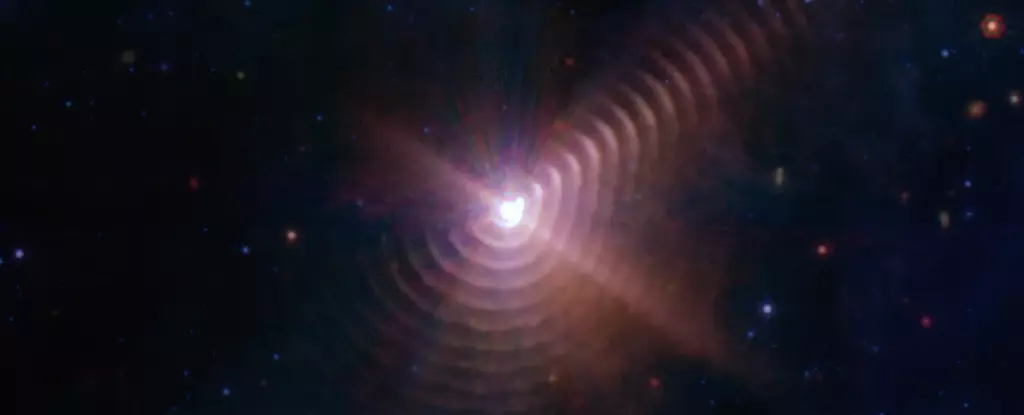Cosmic dust—an intricate tapestry of carbon-rich particles—plays an essential role in the formation of galaxies, stars, and potentially the building blocks of life. For astronomers seeking to explore the universe, however, this dust can often obscure targets, posing significant challenges for celestial observations. The advent of the James Webb Space Telescope (JWST) marks a pivotal progression in astronomical technology, specifically designed to penetrate this veil of cosmic dust using its advanced infrared capabilities. This article delves into the fascinating findings surrounding the WR 140 binary system, illustrating how ongoing research can enhance our understanding of cosmic dust and its vital role in the universe.
Cosmic dust originates from various astronomical phenomena, including stellar winds, supernova explosions, and the remnants of star formation. This dust is crucial for the development of rocky planets and the perpetuation of life as we know it. When astronomers endeavor to capture images of celestial bodies, they often confront cosmic dust that clouds their observations. Recognizing the need for advanced tools to study the universe, researchers crafted the JWST to directly investigate these obscured materials in ways traditional telescopes cannot.
One notable source of detectable cosmic dust is the Wolf-Rayet binary system known as WR 140, situated approximately 5,000 light-years away in the constellation Cygnus. Recent studies published in renowned journals such as Nature Astronomy have unveiled the exceptional nature of this binary star system. The stellar winds from its two constituent stars regularly collide, giving rise to rings of carbon-rich dust that are expelled into space—a process that occurs with predictable frequency around every 7.93 years when the stars reach a point termed “periastron.”
The unique orbit of WR 140 allows researchers to anticipate when the dust will form, creating a rare opportunity to observe changes in this cosmic environment over relatively short timeframes. The chaotic and hostile interactions between the winds from the Wolf-Rayet star and a companion OB star serve as a dynamic laboratory for studying dust formation mechanisms. Researchers continue to grapple with fundamental questions regarding the chemical composition of this dust and its longevity in the harsh environment of space.
The JWST’s infrared imaging capabilities have provided exceptional insights into the dust dynamics of WR 140. Initial observations, conducted around 14 months after the system’s most recent periastron event, confirmed the dust rings’ existence and documented their expansive growth over a remarkably short period. According to experts like Emma Lieb, one of the lead researchers involved in the JWST studies, the consistency and rapidity of the dust shell velocities revealed a complex dynamism not often seen in astrophysical phenomena.
This firsthand observation of the dust shells’ growth adds a new dimension to our understanding of cosmic dust creation. This is especially relevant in the context of astronomical timelines, which typically span millions of years; the construction and movement of these dust rings offer a tangible glimpse of cosmic processes unfolding in real-time.
The active nature of WR 140 distinguishes it significantly from other known Wolf-Rayet binary systems. Its unique orbital parameters enable astronomers to contemplate the potential role these systems may have as factories of cosmically relevant materials. Researchers speculate that evolved WR stars and their colliding winds may have contributed to some of the primordial carbon-rich dust grains and organic compounds in the universe.
As scientists analyze new data from the JWST, projections suggest that WR 140 will likely generate tens of thousands of dust shells in the cosmic expanse over a span of several hundred thousand years. Such predictions raise compelling questions about the broader implications of stellar dust for galactic chemistry and the potential for star formation in the universe—highlighting an untapped reservoir of knowledge embedded within these dynamic cosmic interactions.
Despite the remarkable insights gained through the JWST’s observations, several challenges remain in the study of cosmic dust. Researchers must continue to refine their understanding of the diverse environmental conditions that enable dust formation and dissipation. Notably, while WR 140 provides a fruitful cosmic laboratory, its ultimate fate mirrors that of many Wolf-Rayet stars; they tend to culminate in supernova explosions or even black hole formation, severing further dust production.
However, as WR 140 continues its cycle of dust creation, the JWST is invaluable for ongoing and future research endeavors. Its capabilities to observe such intricate processes with unprecedented clarity pave the way for groundbreaking discoveries in our cosmic narrative, enriching our understanding of both the origins and evolution of the universe’s building blocks.
The study of cosmic dust, particularly exemplified by the WR 140 binary system, enhances our comprehension of stellar evolution and the formation of elemental building blocks essential to life. As new data emerges from the JWST, we stand on the cusp of unlocking further cosmic secrets that have long eluded our grasp.


Leave a Reply